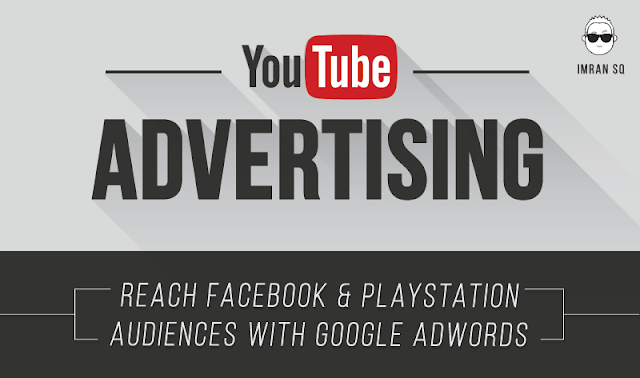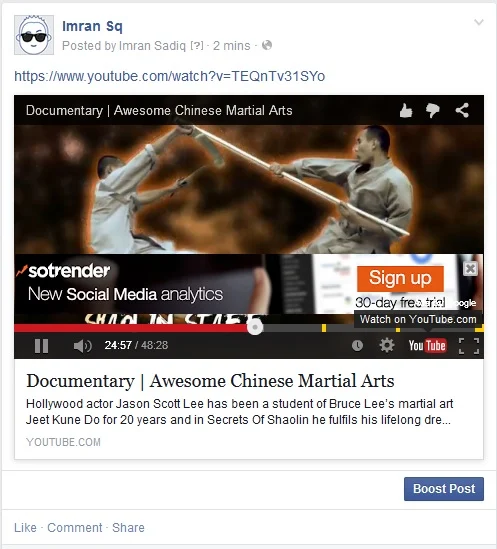When a YouTube video is being watched by your customer and you are given the option to advertise your business to that customer, on that video - would you do it?
It makes sense to target watched (or viral) videos with adverts across multiple networks and devices - a bit like winning a prime time slot on TV. However, sourcing an expert to create and market a video ad for your business is probably equivalent to a prime time nightmare.
As you can see on the share to Facebook (SoTrender ad), some advertisers avoid the problem of needing videos and use text ads/banners instead. Read more below to learn more about YouTube advertising.
In-Video AdWords Banner Ads on Facebook
Why Advertise on YouTube?
If the current 'mobile friendly' trend is your focus, OfCom reported mobile video advertising as the fastest growing ad format in the year examined. Having said that, mobile banners and text ads still account for 83% of ad revenue on mobile devices. If your goal is to be visible on as many devices as possible, 9.9 million (38%) of UK households owned internet enabled set-top boxes and games consoles were the most common method to connect for non-smart TV owners.
In short, YouTube advertising does offer quite a superior level of reach:
- Main Site #Youtube
- Google Display Partners #AdSense
- Mobile #ios #android
- Shared on networks like #Facebook #Twitter.
- Set-top boxes #youtubeapp #browser
- Smart TV #samsung #sony
- Games Consoles #playstation #xbox
1. Pick a YouTube Ad Format
In-DisplayPromoting videos to the top of a YouTube search, right hand side of a YouTube watch page or across a network of publishers opted into receiving ads. CPC / CPM alternatives are available.
In-Stream
Commercial style ’skip after 5 seconds’ ad. Publisher videos with a duration longer than 10 minutes will often have more than a single ad slot. CPC / CPM bidding alternatives allow uploads of 15-20 second adverts and remove the skip button all together.
Banners
Standard options include uploading a text ad or 300x250 banner or using the 480x70 ‘In-Video Static Image’ option, which opts ads into appearing inside YouTube video uploads and shares.
Other YT video advertising options do exist (i.e. live stream, lightbox and more) but the above are generally ‘for everybody’ ads. The two key formats to show your banner or video ads inside videos across are in-stream and in-video. Across all options, video publishers are usually required to opt into
2. Decide to Bid For Clicks or Views
Google offers three key bidding methods to show your ads. How you bid is governed by the type of network and advert used. For every time an advert is about to show, an auction to find the highest bidder, with the highest quality, for the available ad space takes place. Google gives preference to advertisers with a good combination of bid and quality.
Cost-Per-Click pay nothing until user decides to click on advert.
Cost-Per-View pay nothing until until user views 30+ seconds, or full length of advert.
Cost-Per-Impressions pay for every thousand times your ad is shown.
The actual cost for in-stream video ads slots on most videos has been around 0.01 - 0.10 per view for some years now. That's paid AFTER someone watches at least 30 seconds of the advert. I don't know if the same applies to videos on shared networks, but it's very different to the usual multimillion spots on TV. On one hand you pay-per-unit, and on the other you pay for millions of viewers to see a commercial in bulk.
3. Select Audiences or Content

YouTube Trends Map
#CherryPickTargeting use the YouTube Trends Dashboard to identify videos being shared on Facebook and Twitter, or most viewed on YouTube and add them as a manual placement to your campaign.
#PeopleTargeting use existing
#ContextualTargeting use the categories of videos to automatically show your ads on relevant video content, or simply use keywords that match the theme of YouTube video descriptions.
You don't need to directly target set-top boxes, games consoles, smart TV's - simply target the audience or content that audience is viewing. It allows focus on the value of potential customers and the content they view.
Final Note
The three steps above should give you a general overview of how YouTube advertising works. Pick an ad format, select a bid, pick a type of targeting, and your good to go live.Remember, the only time you are guaranteed to get nothing from YouTube, is when you don't try to reach and measure the value of YouTube.
Comment, like, share and engage ;-)
About Imran Sq
Background includes 'Product Trainer' for external google support teams and now contribute tips and tricks acquired from years of strategizing AdWords campaigns. Get in touch!



